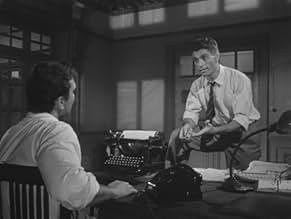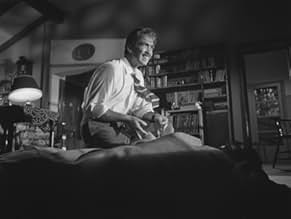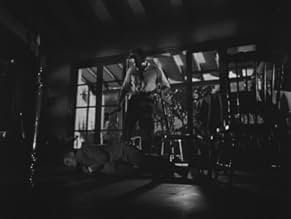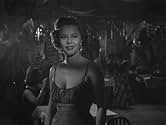NOTE IMDb
7,6/10
887
MA NOTE
Un journaliste déchu s'associe à un immigré hongrois pour créer une fausse école de journalisme par correspondance.Un journaliste déchu s'associe à un immigré hongrois pour créer une fausse école de journalisme par correspondance.Un journaliste déchu s'associe à un immigré hongrois pour créer une fausse école de journalisme par correspondance.
- Réalisation
- Scénario
- Casting principal
- Récompenses
- 2 victoires au total
Otto Webber
- Noriega
- (as Otto Weber)
George Hilton
- Hombre en redacción
- (as Jorge Hilton)
Avis à la une
Based on this 1956 offering I'd say the Argentines have a thorough grasp of noir, no? This dark, curdled tale of not good vs evil but rather amiable crookedness vs evil is utterly fascinating. It's not a case of whom to root for but rather which of the two antagionists do we pity less? Tough call. On the one hand you have the loud, unctuous con artist and on the other there's the tortured, psychotic worm. My sympathies ultimately came down on the side of the later, but it was a close call and was made all the closer by the skilled performances of the two lead actors, Carlos Cores and Vassili Lambrinos, who perfectly embody these twin poles of ethical and moral corruption in mid 50s Argentina, as the tyrannical Peronist era was yielding to a slightly less tyrannical succession of military strongmen, an uneasy time in a country haunted by a repressive and fascistic past and facing an uncertain future. This state of mind is subtly brought out by director Fernando Ayala and his scenarist Sergio Leonardo in such scenes as the nightmares of Gaspar as he confronts his father's Nazi past and the wonderfully ironic ending where a hopeful new generation is planting flowers from bitter stems, unknowingly atop a corpse's grave. Throw in bleak, shadowy cinematography from one of Greg Toland's more apt pupils, Ricardo Younis, and a seductive jazz/tango score by Astor Piazzola and one can see why this film is a near masterpiece. Why near? Didn't like the character of Jarvis who is, in my opinion, unbelievably credulous around an obviously nutso Gaspar. Give it an A minus.
Very dated movie done --part of it-- as expressionistic 1930s German cinema, part as realistic 1950s European neo realism, all mixed up with a very Argentinian way of interpreting the brief and blunt dialogs throughout the whole movie.
The story is quite interesting. It could have been superbly interesting if the script could have been fully developed going deeply into the main character psychology and motives for his behavior instead of the bumpy way shown here so abruptly from one scene to the next (unless I saw a faulty copy with missing scenes).
Our tortured main character motivations for what he does, as seen in this version, is totally incomprehensible, since he has no real proof to take such a drastic measure to solve the dilemma that tortures his feverish mind.
The photography may be the best asset in this film, done in black and white with a very impressive atmosphere, dark and oppressive almost all the time.
The soundtrack is also very good, following the black mood of the story very precisely and to the point.
But the whole feeling disclosed here, either about the city, its people or our protagonists is nowadays as removed from us as a Christopher Columbus ship could be as incongruous standing next to an atomic submarine.
The story is quite interesting. It could have been superbly interesting if the script could have been fully developed going deeply into the main character psychology and motives for his behavior instead of the bumpy way shown here so abruptly from one scene to the next (unless I saw a faulty copy with missing scenes).
Our tortured main character motivations for what he does, as seen in this version, is totally incomprehensible, since he has no real proof to take such a drastic measure to solve the dilemma that tortures his feverish mind.
The photography may be the best asset in this film, done in black and white with a very impressive atmosphere, dark and oppressive almost all the time.
The soundtrack is also very good, following the black mood of the story very precisely and to the point.
But the whole feeling disclosed here, either about the city, its people or our protagonists is nowadays as removed from us as a Christopher Columbus ship could be as incongruous standing next to an atomic submarine.
An Argentinian film noir from 1956. Presented a couple of weeks ago as part of TCM's Noir Alley (& whose host Eddie Muller was one of the champions in saving the lost classic) which details a man's greed overwhelming his soul. Down Argentine way, a reporter, played by Carlos Cores, who's barely making ends meet runs into an opportunistic foreigner who works at a bar who sells him on a scheme to fleece readers of their money for a correspondence school scam but after a while the idea of having to separate the wad begins to weigh on Cores so one night he takes a hammer to his partner's head, burying him in his home's garden. As time passes & his partner's son shows up out of the blue (who also begins a romance w/his daughter), the tale takes a turn for the Hitchcockian (& even shades of Edgar Allan Poe as every time Cores looks out his window to his garden, there the dead body lies) w/great camera set-ups & cinematography (according to the notes I've read on the movie, this film's DP taught the peerless Gregg Toland back in the day) & an ending which would shame purported American noirs of the period (the Hays code demanded the bad guy get his). The title's translation is "The Bitter Stems" by the by.
THE BITTER STEMS is a 1956 Argentine Film Noir and is one of two new releases from Flicker Alley and the Film Noir Foundation that showcase two "lost" movies from 1950s Argentina. It was based on a best selling Argentine novel and is on AMERICAN CINEMATOGRAPHER's list of the 100 Best Photographed Films of all time. The cinematographer, Ricardo Younis, was a pupil of the legendary Gregg Toland (CITIZEN KANE) while Fernando Ayala was emerging as one of Argentina's top directors. After being acclaimed on its initial release, it disappeared for many years before being discovered at a private collector's home. Restoration was done at the UCLA Film & Television Archive.
The story concerns a disillusioned journalist (Carlos Cores) who joins forces with a Hungarian immigrant (Vassili Lambrinos) to create a fake journalism correspondence school so the Hungarian can bring his family to Argentina. It all starts well with the money rolling in and 2/3 going to bring the family over but soon the journalist thinks he is being cheated after the appearance of a woman who is not a family member. It is then that he takes matters into his own hands with tragic results. In addition to solid performances and moody photography, BITTER STEMS features an early score from celebrated composer Astor Piazzola.
Thanks once again to Flicker Alley for continuing their ongoing Film Noir Series in partnership with "Noircheologist" Eddie Muller and to his Film Nor Foundation for rescuing THE BITTER STEMS from oblivion. The DVD/Blu Ray combo comes with a 23 page booklet that is loaded with photos and information. Other extras include a filmed introduction on the movie with Muller, a conversation with Argentine archivist Fernando Martin Pena, and a profile of composer Astor Piazzola. Finally there is an optional commentary from film historian Imogen Sara Smith. An absolute must have for fans of Film Noir...For more reviews visit The Capsule Critic.
The story concerns a disillusioned journalist (Carlos Cores) who joins forces with a Hungarian immigrant (Vassili Lambrinos) to create a fake journalism correspondence school so the Hungarian can bring his family to Argentina. It all starts well with the money rolling in and 2/3 going to bring the family over but soon the journalist thinks he is being cheated after the appearance of a woman who is not a family member. It is then that he takes matters into his own hands with tragic results. In addition to solid performances and moody photography, BITTER STEMS features an early score from celebrated composer Astor Piazzola.
Thanks once again to Flicker Alley for continuing their ongoing Film Noir Series in partnership with "Noircheologist" Eddie Muller and to his Film Nor Foundation for rescuing THE BITTER STEMS from oblivion. The DVD/Blu Ray combo comes with a 23 page booklet that is loaded with photos and information. Other extras include a filmed introduction on the movie with Muller, a conversation with Argentine archivist Fernando Martin Pena, and a profile of composer Astor Piazzola. Finally there is an optional commentary from film historian Imogen Sara Smith. An absolute must have for fans of Film Noir...For more reviews visit The Capsule Critic.
I've always searched great but unknown films noirs from outside USA, in England of course, but also France, Italy, Scandinavia, Egypt, South America and especially Argentina.
I just discovered this Argentinian noir movie, and it's a must. A real tough brainstorming in music, cinematography, script, acting. A constant crescendo creepy atmosphere about a man possessed by nasty war II nightmares. Very intelligent use of music by Astor Piazolla , wonderful cinematography by Ricardo Younis (Gregg Tolland's student). And what an ending, never seen such a cynical one. Bravo.
I just discovered this Argentinian noir movie, and it's a must. A real tough brainstorming in music, cinematography, script, acting. A constant crescendo creepy atmosphere about a man possessed by nasty war II nightmares. Very intelligent use of music by Astor Piazolla , wonderful cinematography by Ricardo Younis (Gregg Tolland's student). And what an ending, never seen such a cynical one. Bravo.
Le saviez-vous
- AnecdotesAs discussed on TCM's Noir Alley by host Eddie Muller in July 2021, a screening of the restored 35mm print of this film was held on behalf of the Film Noir Foundation at the Museum of Modern Art (MoMA) in New York City in February 2016, and shockingly in attendance was 90 year-old Vassili Lambrinos, who, after years of living in various parts of the globe, was living just a few blocks from MoMA. Lambrinos had never seen the film on the big screen nor with an audience before that screening, having seen the film only in an editing room before then.
- Citations
Andreani: You make him infallible. You have an old passion; the need to obey.
Alfredo Gaspar: Passion to obey?
Andreani: To be a subordinate.
- ConnexionsReferenced in Preserving Memory: Fernando Martín Peña on Argentine Cinema (2024)
Meilleurs choix
Connectez-vous pour évaluer et suivre la liste de favoris afin de recevoir des recommandations personnalisées
Détails
- Date de sortie
- Pays d’origine
- Langue
- Aussi connu sous le nom de
- The Bitter Stems
- Lieux de tournage
- Plaza de Mayo, Buenos Aires, Argentine(Gasper and Jarvis walk in the Plaza de Mayo and look at the Cabildo.)
- Société de production
- Voir plus de crédits d'entreprise sur IMDbPro
- Durée1 heure 30 minutes
- Couleur
- Mixage
- Rapport de forme
- 1.37 : 1
Contribuer à cette page
Suggérer une modification ou ajouter du contenu manquant





























